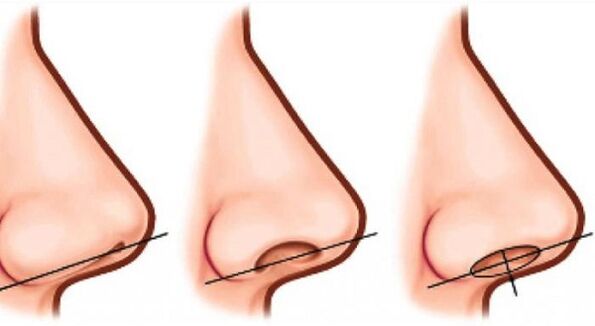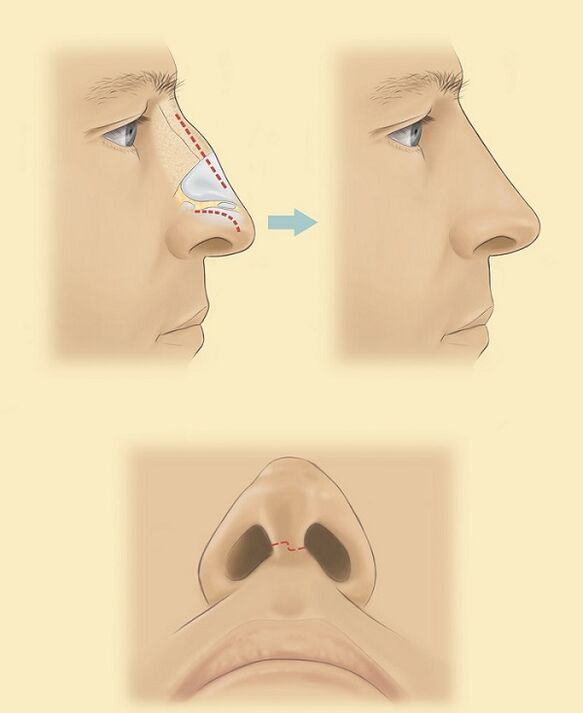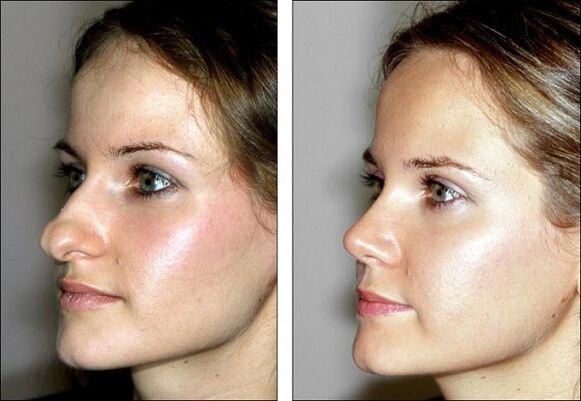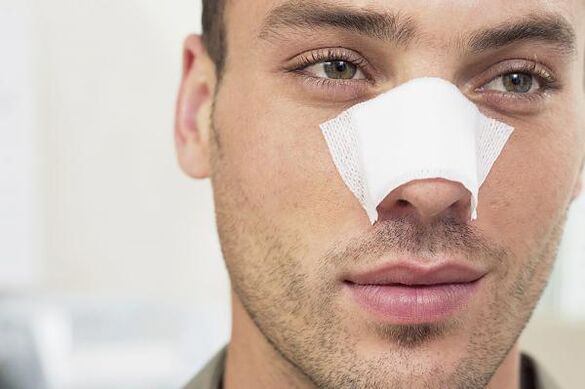More and more people are dissatisfied with their appearance and try to correct some parts of the body in some way. Sometimes there is talk of insanity, but more and more people are completely indifferent to it, because the demand for plastic surgery is growing every year. For example, rhinoplasty is an opportunity to correct the shape of your nose, blepharoplasty corrects the eyelids, and so on.

What is rhinoplasty
Rhinoplasty is a procedure that changes the shape and size of the nose if desired. The first such correction was made in the first half of the last century by a German surgeon named Jacques Josev. After this successful experience, this type of surgery became more popular every day and became easier and safer thanks to the constant development of medicine and equipment. This surgery is to change the cartilage of the nose immediately after removing the skin. Although such a procedure is already very popular, there are many myths that can scare the patient in one way or another.
Myths and reality
The first myth says that any plastic surgeon can perform such an operation. In fact, a doctor in this specialty must be able to master at least the knowledge and the most superficial skills. Unfortunately, this does not mean that there is enough practical experience to carry out such an operation at the highest level. This procedure is very complicated, and any plastic surgeon must know all the nuances and subtleties of the structure of the nose and respiratory system, because the main task is not only the attractiveness of the patient, but also the proper functioning of the body after organ. operation. In this case, the doctor must observe the aesthetic proportions of the face.
There is an opinion that rhinoplasty of the nose is performed mainly for people who are tempted to rebuild their bodies. But the truth is that if the respiratory system is not working properly, the doctor can prescribe such an adjustment. At the same time, there is no denying that a beautiful and elegant nose gives more self-confidence (especially for women) and will definitely change your life for the better. However, it is completely wrong to accept this operation as the satisfaction of one's inner "ego", but rather a modern form of psychotherapy.
Rumors that nasal rhinoplasty is a painful operation are not unfounded. Like any other surgical procedure, it carries some risks, but the former is less dangerous than the same breast augmentation. As for the pain, the patient will not feel it, because the whole procedure is performed under general anesthesia. Swelling and mild discomfort last for 5-7 days after surgery, but no more.
Some people think that rhinoplasty is better in the spring or summer, but in fact this is a pure myth, because the procedure can be performed at any time of year.
The best rhinoplasty is an operation performed by a professional doctor, after which there will be no trace of the intervention. Whether the operation is noticeable depends primarily on the degree of curvature.
Do not think that rhinoplasty can completely change the shape of the nose to make it perfect. Many things are limited to the individual characteristics of the structure, skin and bone-cartilage frame, so patients may be dissatisfied with the outcome of the operation. Thus, according to statistics, every tenth patient returns to the doctor to change his shape after the tissue has healed.

A new nose choice
A computer diagnostics is performed to take into account the capabilities of the doctor and the requirements of the patient, after which a photo will be provided. If the shape of the nose does not allow to achieve the desired result, rhinoplasty and therefore the surgeon himself can not go beyond safe intervention. But the doctor will be able to suggest an intervention as close as possible to the ideal.
Based on the aesthetics of the nasal parameters, more attention is paid to the profile angle calculated by the line connecting the chin to the forehead relative to the back of the nose. As for women, nasal surgery of the tip of the nose while lifting slightly above the plane is important for them. Thanks to this correction, the face is noticeably younger. Keep in mind that the shape will be chosen by the surgeon taking into account as many facial parameters as possible. The operation should be performed in such a way that the nose is not only compatible with the rest of the body, but also individual to the owner.
Types of rhinoplasty
Rhinoplasty is a type of surgery that is represented by several types:
- open interference;
- surgery without skin removal (closed);
- use of fillers;
- repetitive (secondary);
- columella surgery;
- change in the shape of the nostrils;
- extensive nasal rhinoplasty.
As for the first method, the doctor makes an incision directly along the bridge between the nostrils, thus obtaining the maximum possible view for the surgeon. In this case, full control over the operation is possible. During the closed method, the incision is made from the inside, which makes the shape of the nose less traumatic, as it does when using fillers. Other types of interventions are determined by individual anatomy.

Rejuvenating rhinoplasty
Recently, the most popular type of rhinoplasty is a procedure that focuses on the effects of age-related growth on swelling of the nasal dorsum, drooping of the tip and bottom. Over time, it grows larger and more prominent, which makes a woman look older. In addition, the ears grow with age, so the surgeon must take this into account when correcting, so that everything is proportional. Even when lifting the face, it is often necessary to straighten the nose associated with the new facial contour. By the way, anti-aging rhinoplasty is the most individual type. The cost of this type of adjustment will also vary in each case.
Contraindications
There is a list of conditions under which the operation is not carried out:
- Rhinoplasty is not performed until the age of 18, unless there is a necessary measure after the injury.
- Inflammatory processes of the skin of the nose.
- Serious diseases of the internal organs that can cause complications.
- Infectious, oncological and acute viral diseases.
- Diabetes.
- Blood diseases.
Preparing for surgery
High-quality rhinoplasty means, first of all, a complete understanding between the doctor and the patient. During the first appointment, the surgeon must listen to all requests. In addition, according to the requirements, the doctor should discuss possible methods that will be appropriate in a particular situation. It then evaluates the various nuances that may directly or indirectly affect the course of the transaction. The choice of a particular technique is based only on the following parameters:
- customer requirements;
- structure of the nasal osteochondral corset;
- skin condition and thickness;
- age of the patient;
- face type.
At the same stage, it is necessary to conduct computer modeling, the purpose of which is to create a virtual image of the nose using a special program. Due to the choice of surgical technique, the initiative is completely in the hands of the surgeon. A comprehensive history is taken.
The doctor should inform the patient about proper preparation for surgery. These include the exclusion of certain foods, the compulsory cessation of smoking, and the restriction of certain fluids, especially alcohol.
Surgery may be postponed if the patient has a recent skin infection or upper respiratory tract disease. About 1-2 weeks before the correction procedure, drugs containing salicylates should be completely abandoned.
Operation
There are currently a large number of private and public clinics where rhinoplasty can be performed. Prices in such medical institutions are determined by the level of the institution, the equipment, the professionalism of the doctors and, of course, the procedure they offer and perform. Local anesthesia is often used and several sedative cubes are injected into a vein. There are times when general anesthesia is required. During the operation, the patient is constantly under the constant control of special computerized equipment that monitors the stable work of the heart, pulse and pressure.

At the end of all surgical interventions and procedures, the patient is transferred to the department. Often there may be some discomfort, but all are quickly eliminated with appropriate targeted medications. Some surgeries require a special shot to keep the nose still and to prevent accidental bruising. If rhinoplasty of the tip of the nose is performed, a special triangular bandage is applied to the support, it is possible to use the inserted nostrils. It is possible to leave the clinic within a few hours, but some patients decide to stay overnight.
Realise
The operation itself does not take very long, lasting about several hours, all depending on the chosen method of intervention and the initial complexity.
The first stage involves cutting the vestibule of the nasal mucosa. The surgeon is then required to straighten the tip of the nose, sometimes changing the height of the nostrils and the width of the base of the nose. After the knot or nose is removed, the necessary appearance is given, a final correction is made using cartilage, or they can be themselves, or protected. During deformities, the operation is performed in parallel with the change in the condition of the nasal septum.
It should be noted that after all the manipulations performed, the nose underwent some changes that the surgeon could not predict with 100% accuracy, as evidenced by the large number of photographs. Rhinoplasty is a very complex procedure, but there are still a small number of unsuccessful interventions due to the individual characteristics of the patient.

Possible complications
Any surgical intervention on the body is not natural and does not leave a mark, and rhinoplasty is no exception. Of course, surgeons must be at a high level, but sometimes there can be complications associated with exceptional features. These include:
- anatomical structure;
- reaction to anesthesia;
- wound healing;
- nosebleeds;
- general reaction of the body to surgery;
- infection.
The risk of complications can be reduced to zero if you carefully follow all the recommendations of your doctor.

Salvation
In the first days after rhinoplasty, the nose can cause some discomfort. The appearance of swelling around the eyes is also noted, but no trace will remain after 4 days after surgery. After 2 weeks, the nose will almost complete its final shape, but still full formation occurs within six months. During this period, special care should be taken when caring for the skin in the nasal area, as it will be especially sensitive to damage. During this period, it is recommended to refrain from visiting the sauna and wearing glasses for a month and a half.

Return to normal exercise
If you do not put a lot of physical effort on yourself, you can start your daily life or even work within 1 week after the operation. When it comes to recovery, it is recommended that you start as early as 3-4 weeks. You should also avoid direct sunlight on your face. In fact, any person can perform rhinoplasty, but the desired result will be achieved and strengthened only in full compliance with all the recommendations of the doctor.




















